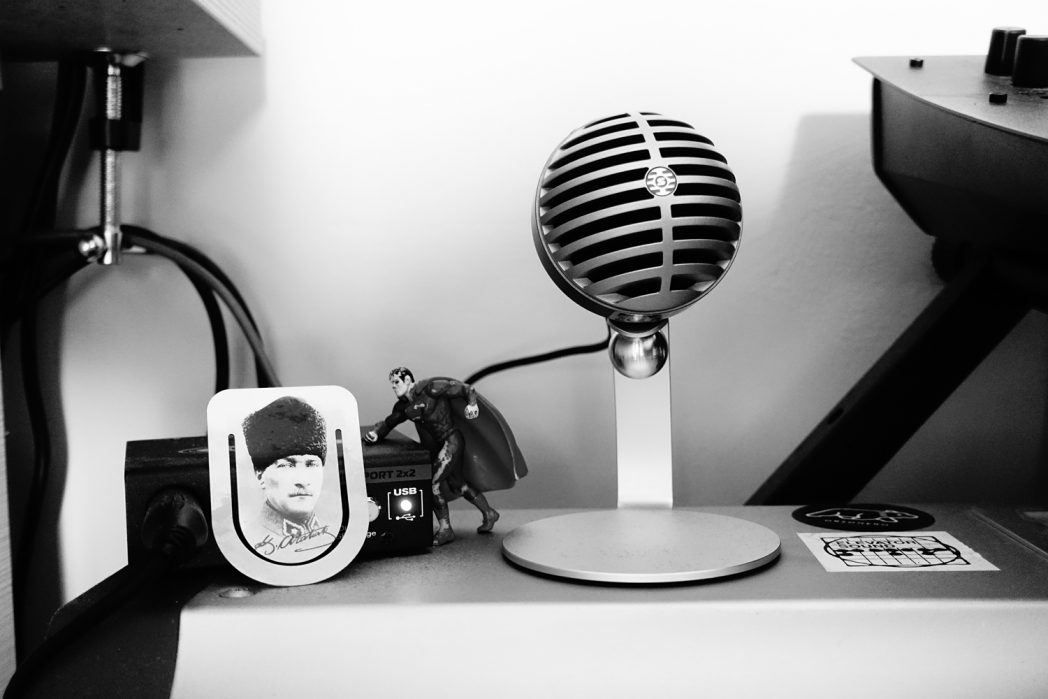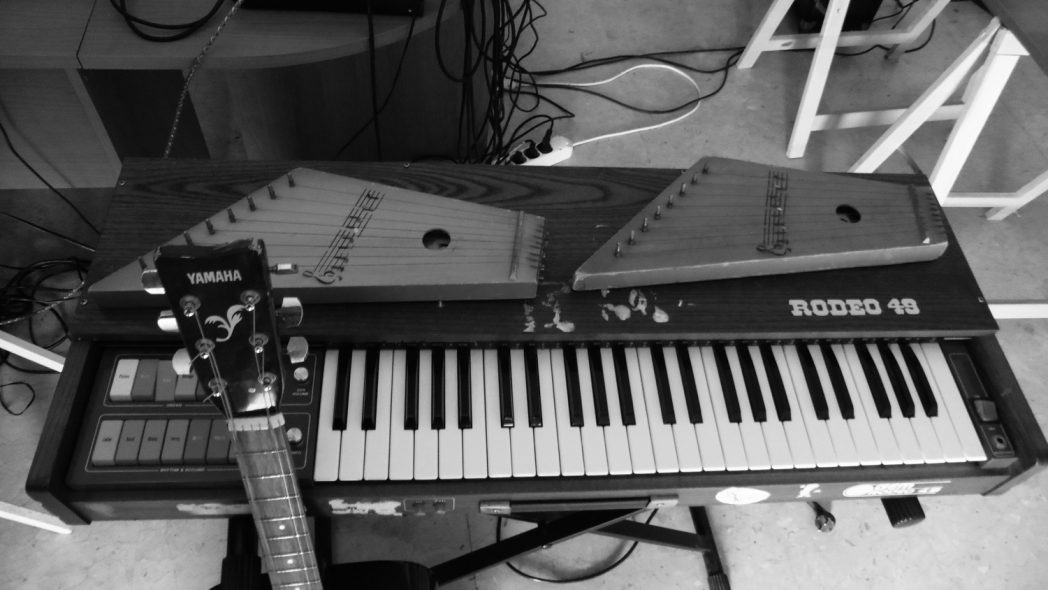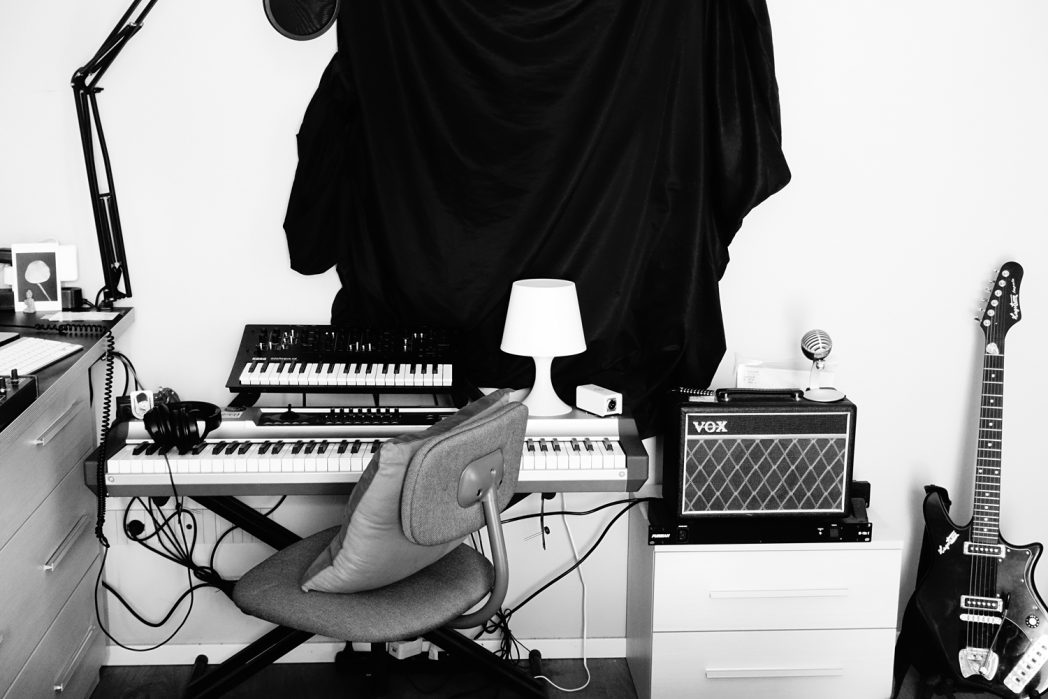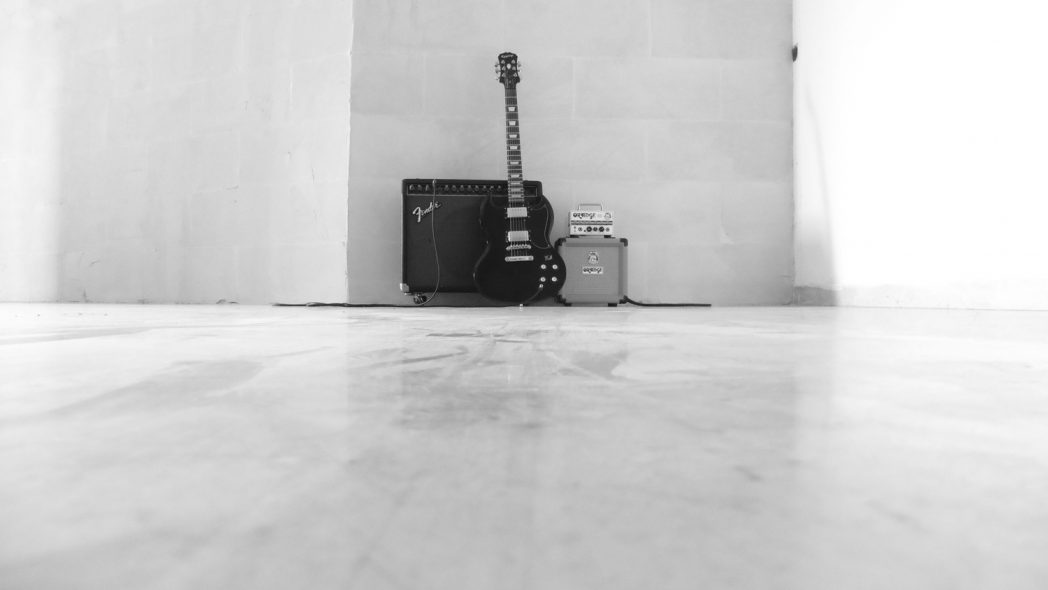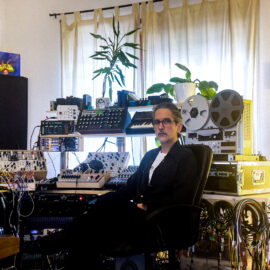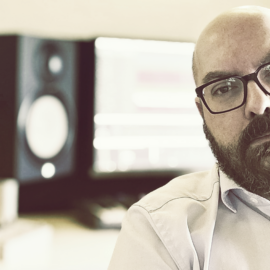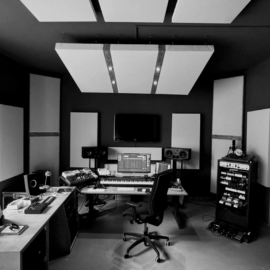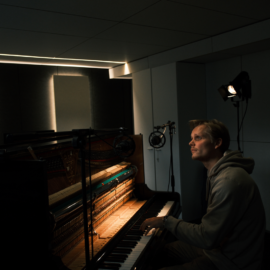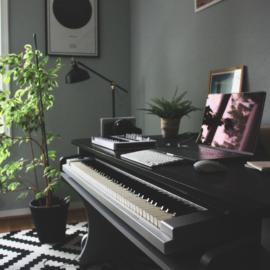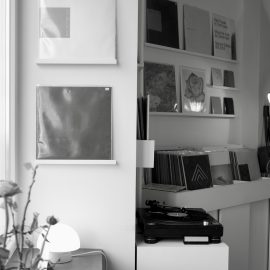Let’s start at the very beginning. Can you tell us how you got involved in composing, and what was your very first piece of gear?
Rob: I guess we both started writing music in bands in our early days. I personally used to play the guitar and sing abstract lyrics of my own in a quite aggressive, loud and melancholic way. I was into some sort of indie rock, or so-called, until something like 10-12 years ago. That was quite like an intensely physical way to perform, with a huge amount of wall of sound on stage. I remember very vividly that I stressed my ears in a way that I had some severe forms of ear disorders (I still have to be really really careful with my left ear nowadays). After a little while, I started writing some quiet and gentle music on my own with synthesizers instead (mostly ambient music before, and then sound design for theatre, dance, movies etc.) and finally some years ago I started composing for strings and orchestra as I had in my mind the urgency to imagine music in a really different way. Now I consider composing just as a rebellious act. That’s a radical practice to me nowadays, and it’s way closer to paint actually than music, I believe, if this makes any sense.
Attilio: My first piece of equipment was a Japanese Fender Jaguar that my parents gave me at the end of high school. This guitar allowed me to start experimenting with sound and composition along with a Fender Frontman 65R transistor amp and an inexpensive multi-effects pedal (Digitech RP 50) which also featured some built-in drum patterns. The first things I tried to do were heavily influenced by post-rock, shoegaze and noise. I would have liked to play in a band when I started playing, but in my city, at that time I was struggling to find someone who had similar musical tastes to mine and a great desire to overcome musical clichés. So after a few failed attempts, I have decided to go on my own. When I added the computer and the synthesizers to my setup, I immediately discovered that the possibilities of translating thought and feeling into sound could be endless. And the inexpressible could be represented.
How many different studio iterations have you gone through, and what does your final setup look like right now?
R: Lots. When I was playing in a band, my studio routine was something ridiculously crazy and nonsensical. Something like having 7-8 guitars each with different tuning, several keyboards, mics and twenty or more guitar stompboxes, three combo amps. That was insanely stressful! So gradually, step by step, I have been really focused on keeping things around me really simple and minimal. I don’t like owning a lot of gear so I only really keep essential things around, otherwise, I could distract myself very easily. Also, I rarely go into professional studios, I kind of feel uncomfortable and weird in those places and I will never get the sound I want. For me, it just doesn’t make sense to be surrounded by gear, definitely too much entertainment and not enough room to dream, so I wouldn’t be able to focus on doing my own thing. Differently, I’m really obsessed with recording in places like churches, empty houses, pools and these sort of things, instead. Also, I normally go to locations where I know I can play grand pianos and things like that. We recorded our new album in this chapel in London for about a good 40% I would say. Anyway, In my place currently, I own a couple of guitars (love the total-black Swedish Hagstrom, that’s a brilliant piece of gear), a small vox amp, a Prophet Synth and Korg Minilogue XD, three or four different microphones, some JBL speakers that perform really well with strings and piano which is crucial for me, several e-bows. I also own a couple of preamps, a hammer-weighted poorly painted Fatar keyboard, a desktop Audient interface, and Ableton Push. I am not really into Ableton to be fair, I normally use it just as an advanced sampler. But I quite like Push as a design object, so I’ll keep it 🙂 Then I have a Martin Margiela book that always helps me going well and with sanity in the mixing process, a couple of Apple Macbooks, a Furman power conditioner, plants and objects that friends gave me (small weird gifts like Japanese wishes, volcanic stones, weird lamps, stuff like that). That’s it!
A: The first setup of my studio was very simple and rough; it involved the electric guitar, several pedals that I constantly bought and resold, including Line6 DL4, Russian Big Muff and Small Stone Electro Harmonix, reverb unit, Dunlop Cry-baby, Dan ElectroFabtone, a vintage electronic organ (Gem – Rodeo 49), Drum Analog Rhythm Synthesizer (Korg Electribe ER-1), an old desktop computer with a cheap audio interface (entry-level M-audio), a MIDI controller Keyboard, headphones (Sennheiser HD-280 Pro) a pair of the old passive speaker (Canton). Gradually I’ve added several pieces; I can’t remember everything I had. Sometimes I used instruments for just one or two records, then I sold them. I have two old MacBook Pros from 2009, they are falling apart with me and the world, but I just can’t think of replacing them. I don’t think I would be able to do anything without them (but sooner or later, it will happen). The main things you can find in my studio are: KRK speakers, Motu Ultralite MK3, electric guitar (Epiphone SG), bass (Cort), two classical guitars (one very old and a newer pink one I borrowed from my niece), amps (Fender Deluxe 85 and a small Orange), microphones (Rode, Sennheiser), a digital piano (Kurtzweil), a Clavia Nord Lead 3, a Shermann Filterbank 2, many pedal distortions, digital reverb unit (Eventide Space), delay pedal (Flashback), e-bow, old zyther, ride cymbal, vintage electronic organ (Gem – Rodeo 49), some controllers, a rabbit skull, some gypsum masks a friend of mine made and the soul of all humans (good and evil) have been there. As Roberto said, the studio for me is a room of dreams, thought and freedom rather than a professional space. Indeed it is a place in which sound deprofessionalizes space and reappropriates reality. All gears are the weapon to make it happen.
Tell us about your favourite piece of hardware.
R: It keeps changing. My favourite piece of hardware is the imagination 🙂 Writing for orchestral stuff is my main thing now but, after a really long time of hate/love affair, I’m starting to build a completely new relationship with electric guitars again. Kind of surprising for me. Let’s see what happens.
A: These days I am really enjoying playing my niece’s pink classical guitar. In any case, I think books are my favourite hardware. Not joking. By reading, I have access to the central part of what is behind my compositions.
And what about the software that you use for production?
R: I’ve been using Reaper as the main DAW for pretty much everything and I’m fully satisfied with it. I use Ableton only as a sampler, for experimental electronics stuff and live applications. I use plugins as well, of course. Some of my favourites are Soundtoys, Valhalla, Arturia, Lexicon, Waves, Grm, Eventide, Sibelius for scores, nothing too crazy. I also use MAX/MSP and Bidule sometimes.
A: Logic Pro has been my favorite DAW over the last decade. I use it for recording, mixing, and editing. For composition, I used a lot of granular samplers in an unconventional way, from Native Instruments Reaktor to some MAX/MSP patches. Ableton is, for me, something between a sampler and a recording/improvising platform. I used it also for playing live. I like a lot Audiomulch and a bunch of plugins from Waves, SoundHack, GRM and Giorgio Sancristoforo’s stuff.
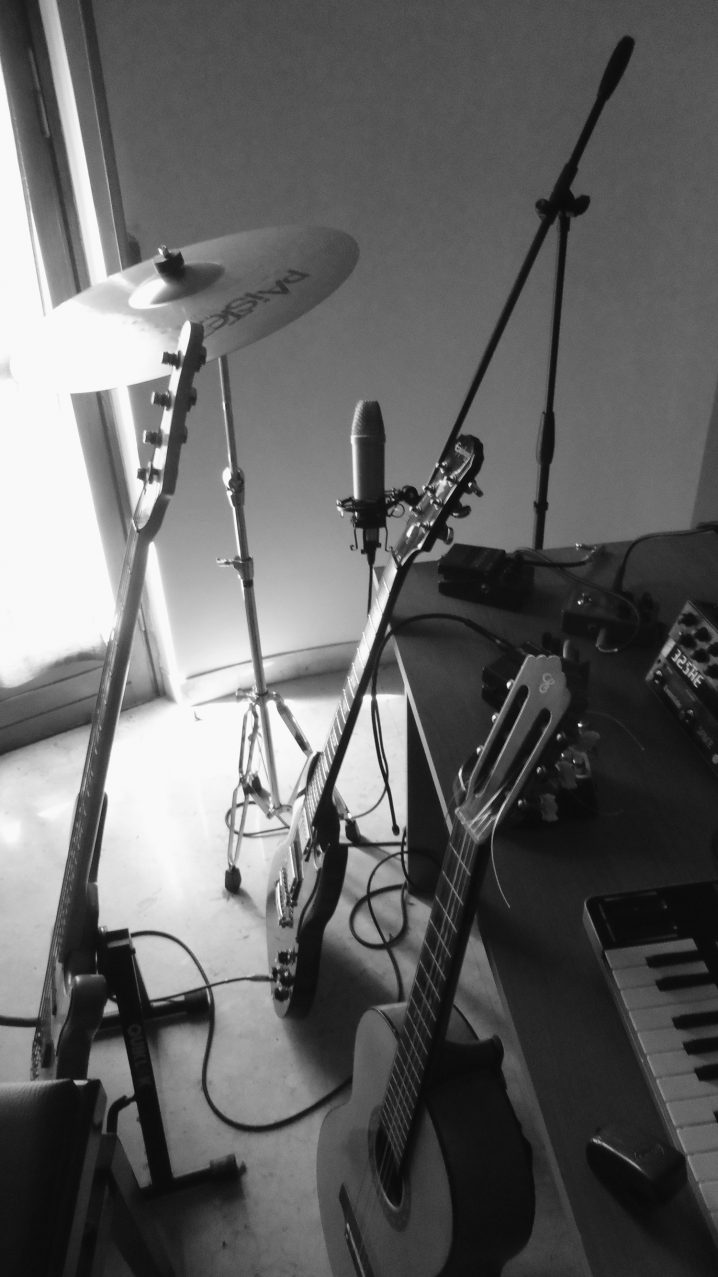
Is there a particular piece of gear that you’re just dying to get your hands on and do you think one day you’ll have it?
R: I don’t think so. Maybe I would have the Steinway and Sons Grand Piano I played in Rosslyn Chapel in my studio. But that would not be the same anyway.
A: I also dream of playing that grand piano that I will never be able to afford and an ancient lute.
Can you please share some aspects of sound design in your work?
R: That’s something really changeable and mysterious that I can’t elaborate on.
That’s always different and not a fixed practice.
I make mistakes and I like that.
I dream and I like that.
Then I make mistakes about dreams and I like that too
Repetition. I like that.
I keep watching animal behaviour and I like that.
Sometimes, something is blooming, playing with piano or other stuff for hours but generally speaking is a bit more abstract than this. It’s a freaking cool mix of abstraction, mystery and primitive force for us.
A: I believe there are two aspects of sound design. One is purely compositional and the other is aimed at producing a piece in the desired way. In Luton these aspects, while both are present, they have a different specific weight. The sonic sculpture is created within the composition and sound, smoothing and subtracting the superabundant and multiplying the necessary. Many pieces consist of nearly 100 separate tracks, so making everything sound organically in the mix, finding a place for each sound in the space is a beautiful and intriguing challenge. Also devastating sometimes for both of us.
Any particular new techniques that you tried out for your new album?
R: I explored the piano in a lot of different ways, using a lot of natural reverberation and use of spaces and for the first time I played a Matthew Copley pipe organ in this stunning London Chapel I am deeply in love with. I also wanted the orchestra to be an extension of something I had in my mind for a long time. In terms of composition, I think what I had inside me with strings and horns in Eden is what eventually makes the whole thing vastly feverish and ever-changing and I can’t put this in language, I’m afraid. It’s fun because, you know, that’s more like painting or drawing abstract lines. Most of the time, we have not any idea what’s going on and you know what? We feel massively grateful about that.
We look for something that gives us a glimpse of the heat-death of the universe.
A: In this record, we worked step by step and massively on the (micro) details. On some pieces there is a gentle electronic treatment and looping work on the piano, this is a so delicate balance to be mixed up with the organic sound of the piano recorded in London Chapel. Apart from that, I tried to get a classical guitar sound, almost 70’s/mediterranean inspired, and I also used some sidechain compression tricks to make the sound moving in waves, like in a suboceanic way.
What does your live setup look like, and what do you bring with you when you travel for an extensive tour?
R: We don’t do extensive tours because performing Luton live could be really challenging, but when this happens I normally keep everything simple on my side. I am normally in charge of playing a grand piano that we generally ask to the venue and playing out electronic bits with samplers and fx chains with laptop and external processors. But the main effort is on the piano for me. I have my way of playing which is fairly unorthodox, obsessive and not in strict structures that requires me great hassle. Attilio is in charge of delivering a beautiful wall of sound and sonic particles around me. Also, silence and darkness in performing are really crucial to us.
A: My setup could vary a lot, it depends on the kind of performance I’m going to do. I usually bring several pedals, a sampler, a synthesizer and controller, and a laptop with me. I also ask the venue for a guitar amplifier whenever possible.
But I believe we can do it well in any case. I’ll tell you, for instance, that when we played a beautiful concert with Luton in Gdansk, Dni Muzyki Nowej festival in 2019, the luggage with my instruments got lost on my flight. I had to buy some gear from a music store, and I played with stuff I’ve never used before. But it worked anyway.
R: Yeah, that was insane, haha!
What is the most important environmental aspect of your current workspace and what would be a particular element that you would improve on?
R: I just want it to feel comfortable and warm, with natural light, paintings and plants, nothing fancy or hip. I have a really nice and vibey view out of my window (I currently live in a Unesco Heritage Site) and I can watch animals doing their own business, which helps make me feel connected to the outside whenever I’m deeply stuck internally.
A: Low lights and darkness are also very important to me. For the rest, I think it is necessary to know well the places. I started making music in my bedroom and it took me a while to get used to working somewhere else. It is very important to feel the studio like an extraterritorial area inaccessible to pain, suffering, and all problems we have in our life. I believe there is a spiritual link between space and making music that takes time to develop. I hope that the future will give me an even stronger bond with the studio or, at least, that this relationship remains alive.
What can you tell us about your overall process of composition? How are the ideas born, where do they mature, and when do they finally see the light?
R: Intuition is everything. Catching ideas is everything. Nothing else really counts to me.
You have to accept everything you will meet in the process and admit yourself that is hard work.
You are gonna see light and darkness. Ups and downs. Heaven and Hell.
It’s a long way to see ideas going in the final stage.
Get a setup.
Sound is just like a seed. You have to take care of it.
A: Several steps in the compositional process lead to a Luton piece being done, and the road to get to the end of a piece could be so long. The initial phase very often for me comes from working on an acoustic instrument. I sketch a melody following an emotional input and then let it grow for a long time, improving it day after day. It can take a long time until I decide to record it. After a first editing and some initial arrangements, I send it to Rob, the master of the arrangements. From the seeds I sent him, a plant come back to me. A song with an identity that I take under my care and enrich again. Sometimes this process is doubled, triplicate by multiple variations. The last step of a Luton track is the mixing, which we consider a really crucial artistic part of the process. The mood, the life events that we live in each phase clearly influence the result. As I said before, the spark to start composing comes to me from reflection, from reading and from my way of feeling the world and relationships with other human beings and animals.
After the piece is complete, how do you audition the results? What are your reactions to hearing your music in a different context, setting, or a sound system?
R: I have a personal test for this, yeah. Lying on the floor in pitch darkness, playing the results with headphones or speakers. Then, there’s stage two. Car test. Driving with the music.
A: After the final mixing tweaks, I listen to a piece many times. The final listening I do is crucial. It’s in a specific place in the studio, in the dark, I also turn off the laptop. Absolute focus is required for this immersive listening that remind me of a trance experience. I also need to lie down on the floor, sometimes. Listening on other systems and especially with other people embarrasses me a lot, I think I would feel more comfortable if I were naked. I also love listening to the songs alone, in the car, possibly when driving fast by night.
Do you ever procrastinate? If so, what do you usually find yourself doing during those times?
R: Procrastination is part of the process indeed. Doing nothing productive is really underrated to me and so, perfectly acceptable. That’s a stigma I’ve never understood really. If you relax and be patient, your mind will answer most of the questions.
A: I really believe that inoperativity, the deactivation of work/activity to obtain a goal, also an artistic goal, is a generic mode of potentiality that characterizes human beings as potential beings have no proper ergon (work); we are argos, without opera, inoperative. So procrastination, as the contemplation of the potentiality, to do or not to do, is something to take seriously if you are interested in the human condition rather than social constructs.
What gets you inspired?
R: It could be anything. People’s nature, friends, philosophy, woods, Anatolian carpets, fragrances, food, writing, animals, art, sexuality and so on.
A: Children, gorillas, stars, philosophy, poetry, my mother’s eyes, just to name a few. And, unfortunately, all my broken dreams.
And finally, what are your thoughts on the state of “electronic music” today?
R: I bet there are loads amount of good music out there, of course, and will always be! Although, I do find it fairly difficult listening to much music in the most recent times. I keep listening to some old favourites of mine, of course, and keep discovering some bits here and there that I don’t know really well. But generally speaking, way less than I used to. It’s not one of my most radiant times as a listener hehe 🙂 But, I have to be clear about this, it’s not like the world’s gone to shit now and stuff like that at all. I don’t know how to explain it a better way and most probably it’s just a matter of approach or maybe I listened too much in the past, I guess. Also, It seems like quite a lot of music nowadays is trying to guide you on an established path and I am sort of struggling with that, I think.
A: I am curating a monthly broadcast called Angelus Novus for the French web radio Camp Radio, so I’m forced to listen to a lot of new music regularly. I think the state of electronic music is good, there are so many beautiful records that come out every day. You have to find them because the best things are not always the most celebrated ones. There are many hidden treasures out there. Very good old and young artists. I would not be so sure instead of the listeners’ state, it is difficult to find someone willing to listen to some music with the right attention, even among journalists or enthusiasts, I fear that it all ends in a bulimic and distracted accumulation of sound. A critical aspect is that musical communication and live shows booking are too tied to business and marketing dynamics in my opinion.

